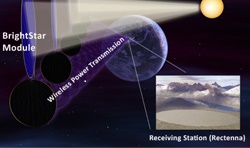| |
| Frequently Asked Questions |
| Why put solar collectors in orbit?
Energy from the sun is 5 times more powerful when collected in orbit than it is by the time it reaches even the brightest desert on Earth. Our atmosphere filters out over 50% of the sunlight it receives, and that doesn�t even factor in the potential for cloud cover. In addition, nighttime darkness greatly reduces the capacity of Earth-based PV systems. The biggest advantage for powersats over earth-based solar power is that powersats receive sunlight 24/7, allowing them to operate at 100% capacity all of the time, receiving over 25 times more power than a ground-based system of the same size. |
| |
What if space debris collides with it?
Collision with space junk is unlikely for a number of reasons. First, PowerSat reside in a geosynchronous orbit which is much higher than the low earth orbit debris band. Second, the surface area of the powersat is thin-film solar cells. Thus, a piece of space junk would go right through the thin film and would affect only a fraction of the output of that module, as there are many solar cells within a module. We could conceivably lose a module if a piece of junk collided with the core control system for that module, but the output of one module is only 1/300th the output of the entire satellite and can be easily replaced. |
| |
| How does the receiving station work?
The power beam is received by a large antenna array on the ground. This array consists of widely-spaced poles with cables stretched between them, supporting small, inexpensive antenna modules. The land beneath the receiver remains suitable for range or agriculture. The received power is conditioned, and then placed on the existing grid, ready to service customers. |
| |
| What is the cost of building and launching this system?
The capital cost of a PowerSat is dependent on several factors, including the total power to be delivered to the grid and transportation costs to low earth orbit. PowerSat Corporation estimates roughly $3-4 Billion for a 2,500 megawatt plant. This compares favorably with a large hydro project or a nuclear power plant of the same capacity. |
| |
| Is it Safe? Is there any concern about radiation from the beams? Can you stand in the beam?
The powersat energy beam is incredibly safe and secure. Overall, the radio frequency radiation in the beam has less of an effect than an ordinary cell phone. The beams are directed only at the receiving stations and do not pass through the collectors. It is physically improbable that a human would be exposed to the path of the beam, as it would require being above the receiving stations, which are elevated 25 feet above the ground. Airplanes are able to safely cross the path of the beam without any kind of problem because the beam bounces off of the aluminum of the plane. Today, thousands of communication satellites, GPS and DirectTV transmit energy from space. Powersats utilize similiar technology. |
| |
What is your timeline for getting to commercial power
transmission?
PowerSat is anticipating being able to transmit power to commercial customers in 10-12 years. |
| |
Is this technology feasible? What makes it ready for development
today?
The advances in technology have made materials lighter and cheaper, making it economically viable to utilize powersats for baseload generation. A key enabling technology has been the development of thin-film solar cells which dramatically reduce the weight of the satellite. We also have a patented technology in the works to decrease launch cost. As well, the drive for carbon free renewable baseload power has now made powersats a viable economic alternative. |
|
|
 |
| |
| What do all these acronyms mean?
Many over the past 30 years have tried to brand and re-brand the concept of beamed energy from solar power in space. Here are a few acronyms, with their meanings.
SSP � Space Solar Power
SBSP � Space Based Solar Power
SPS � Solar Power Satellite
PS � Power Satellite (PowerSat)
SPSS � Solar Powered Satellite System |
| |
| How long do they last?
The lifecycle of a powersat is approximately 30 years. Over that time period, the modules lose about 18-20% of their total generation capacity. However, because the powersat is made up of smaller modular solar panels, when certain modules begin to lose efficiency, it is easy to send new ones up to replace them, without a significant cost investment. |
| |
How do you get the satellites up into space?
Launching a powersat is very similar to launching a communications satellite, and uses the same technology and equipment. Where PowerSat�s satellites differ is in the way they travel from low earth orbit (LEO) to geosynchronous earth orbit (GEO). Unlike any other satellite, PowerSat satellites use electrical thrusters instead of chemical propulsion to move between LEO and GEO, thus decreasing the total weight of the system by 67% and the cost of launch by roughly $1 billion for a 2,500 MW power station. The base structure is inflatable � sent it up in a tight package, and then blown up to full size. |
| |
Can it be turned into a weapon? Is it vulnerable to attacks?
No. The energy transmitted from the Powersat is benign. The radio frequency of the transmission is too diffuse to be considered harmful to biota according to research. Being based in space, a powersat is much less vulnerable than other parts of our energy infrastructure. |
| |
Is the powersat�s transmission ability affected at all by Earth�s
shadow?
Because the PowerSat orbits much higher than Low Earth Orbital satellites, PowerSat is only affected by the earth’s shadow for very brief periods during the fall and spring equinox. |
|
|